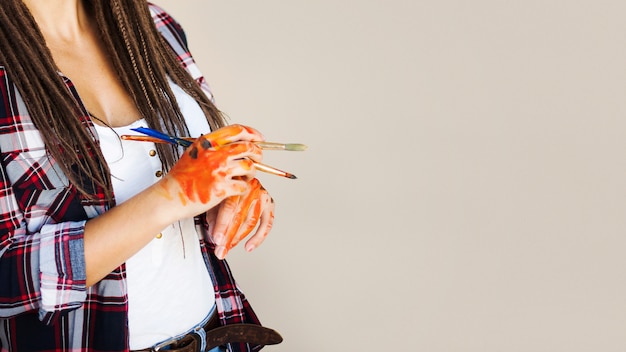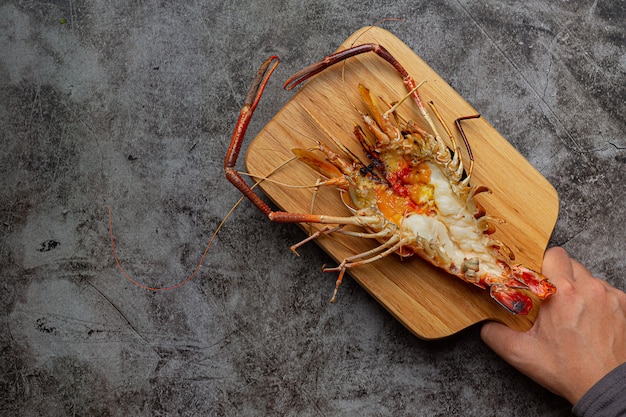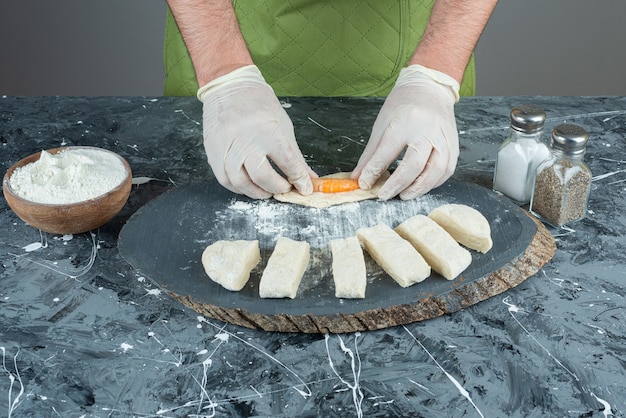Oh, crab legs! There's just something about cracking open those shells and savouring the sweet, succulent meat. It’s a real treat, but it can be a bit tricky getting the timing right. Overcook them and they become tough and rubbery. Undercook them and, well, you might be in for a bit of a fishy surprise. As someone who's spent years perfecting the art of seafood, I've had my fair share of crab leg mishaps. But I've also learned a thing or two about how to get them absolutely perfect. And I'm here to share my secrets with you.
So grab your bibs, sharpen those crab crackers, and get ready to delve into the delicious world of crab legs. We're going to cover everything from choosing the right kind of crab legs to perfecting your cooking technique and creating mouthwatering sauces. Buckle up, because this is a culinary adventure you won't want to miss!
Part 1: Navigating the World of Crab Legs

Before we dive into the cooking, let's take a moment to appreciate the sheer variety of crab legs. Each kind has its own unique flavour and texture, so knowing the differences is essential for choosing the best crab for your meal and getting the cooking time just right.
1.1 The King of the Sea: King Crab
Imagine a crab leg so long it could practically be a weapon. That’s what you’re dealing with when it comes to King Crab. They’re the undisputed champions of the crab leg world, boasting legs that can reach a whopping 10 inches in length! These magnificent crustaceans are not only impressive in size but also famous for their delicate, sweet flavour and firm, meaty texture. Just be prepared to shell out a bit more for this culinary gem.
1.2 A More Affordable Option: Snow Crab
Snow Crab is a fantastic alternative to King Crab, offering a similar deliciousness but at a more budget-friendly price. It has a subtly sweeter and more delicate flavour than King Crab, with a texture that's a touch less firm. The smaller legs also cook faster, which is a huge bonus for those who want a quick and easy meal.
1.3 The West Coast Favourite: Dungeness Crab
Coming from the chilly waters off the Pacific coast of North America, Dungeness crab is considered by many to be the "best crab" around. It has a unique flavour profile that blends sweetness, richness, and delicate notes. It also boasts a nice, firm texture, and its smaller legs cook up surprisingly fast. So, if you're looking for a premium crab experience that won't keep you in the kitchen all night, Dungeness crab is the way to go. Just be prepared to pay a bit extra for this top-tier crustacean.
1.4 The Unexpected Delight: Blue Crab
You might be surprised to learn that the vibrant blue shell of the Blue Crab is home to a delicate crab leg that cooks up beautifully. Blue Crab legs have a distinct, slightly salty flavour and a firmer texture compared to other crab legs. While it's often sold whole, rather than just as legs, if you're lucky enough to find them, they cook surprisingly quickly. So, keep a close eye on them if you're using them in your meal.
Part 2: Cooking Methods: Boiling, Steaming, and More

Now that we've got the crab legs sorted, it's time to talk about cooking methods. There are several ways to cook crab legs, each with its own advantages and disadvantages. Choose the method that best suits your preferences and get ready to unleash those delicious flavours!
2.1 The Classic Choice: Boiling
Boiling is the classic way to cook crab legs for a reason. It's simple, fast, and produces tender, juicy crab meat. Simply add your crab legs to a large pot of boiling salted water and watch as they turn a vibrant reddish-orange colour. This method is also great for infusing your crab legs with the flavours of herbs and spices. Just imagine the aroma of fresh dill and bay leaves mingling with the sweet scent of the crab meat!
2.2 The Delicate Approach: Steaming
steaming crab legs is a more delicate method that results in a lighter flavour and tender, moist crab meat. It's perfect for preserving the natural sweetness of the crab. Simply place your crab legs in a steamer basket over boiling water and let them steam until they're cooked through. This method is also a good choice if you're watching your sodium intake, as it requires minimal salt.
2.3 The Flavourful Choice: Grilling
Grilling adds a smoky flavour and a slightly crispy texture to the meat. Simply preheat your grill, brush your crab legs with a marinade or butter, and grill them until they're cooked through. This method is ideal for those who enjoy a little char and a touch of outdoor flavour in their meals. Just be careful not to overcook them, as they can dry out quickly on the grill. And if you're using a gas grill, be sure to use indirect heat to prevent flare-ups.
2.4 The Easy Peasy Option: Baking
Baking crab legs is a hands-off method that's perfect for those who want to avoid the hassle of boiling, steaming, or grilling. Preheat your oven, place your crab legs on a baking sheet, and bake them until they're cooked through. This method is great for preserving the natural moisture of the crab meat and offers a more even cooking experience.
Part 3: Unveiling the Secret: Cooking Times

Now, for the moment you've been waiting for: the cooking times! But remember, these are just general guidelines. The best way to ensure your crab legs are perfectly cooked is to check them for doneness with a skewer or fork. If the meat is opaque and pulls away easily from the shell, it’s ready to eat!
3.1 Boiling Times
For boiling, a good rule of thumb is to cook crab legs for about 8-10 minutes per pound. Smaller legs will cook faster, so start checking them after about 5 minutes. Be generous with the salt in your boiling water – it will season the crab meat from the inside out, adding a delicious depth of flavour.
3.2 Steaming Times
Steaming is a gentler method, so it will take a bit longer. Plan on steaming your crab legs for about 12-15 minutes per pound. Again, check smaller legs after about 8 minutes. And remember, the meat should be opaque and pull away easily from the shell.
3.3 Grilling Times
Grilling times vary depending on the size and thickness of the crab legs and the heat of your grill. Keep a close eye on them! Start by grilling them over medium heat for about 5-7 minutes per side. Then, check for doneness with a skewer or fork. The meat should be opaque and pull away easily from the shell.
3.4 Baking Times
Baking crab legs is a simple method with consistent cooking times. Preheat your oven to 350°F (175°C), place your crab legs on a baking sheet, and bake for 15-20 minutes, or until the meat is opaque and pulls away easily from the shell. If you're using a smaller oven, you might need to add a few minutes to the cooking time.
Part 4: The Importance of Proper Handling
The art of cooking perfect crab legs doesn’t stop at timing. Proper handling and storage are essential for maintaining freshness and flavour. Here are some tips to ensure your crab legs are at their best.
When selecting your crab legs, choose ones that are fresh and firm. Avoid any that have a fishy odour or are discoloured. If you're buying frozen crab legs, make sure they are individually frozen and not clumped together. This ensures even cooking and prevents them from getting mushy.
Once you've brought your crab legs home, store them in the refrigerator until you're ready to cook them. Keep them wrapped in plastic wrap or a damp paper towel to prevent them from drying out. If you're planning on freezing them, make sure to do so properly to avoid freezer burn. Wrap them tightly in plastic wrap and then place them in a freezer-safe bag. This helps prevent ice crystals from forming and damaging the delicate crab meat.
When cooking your crab legs, be sure to thaw them completely if they're frozen. This will ensure even cooking and prevent them from being undercooked in the centre. Once cooked, you can store your leftovers in the refrigerator for up to 3 days. But let's be real, crab legs are best enjoyed fresh!
Part 5: Unleashing the Flavour: Sauces and Seasonings
Now that we've mastered the cooking basics, let's talk about how to elevate our crab leg experience with sauces and seasonings. A good sauce or seasoning can make all the difference, adding a burst of flavour to the sweet and delicate crab meat.
Here are a few of my favourite crab leg sauces and seasonings that will take your meal to the next level.
- Melted butter: A classic for a reason, melted butter enhances the natural sweetness of the crab meat. You can add a touch of garlic, lemon juice, or herbs for an extra boost of flavour. Try adding a sprig of thyme or rosemary to the melted butter for a fragrant and aromatic touch.
- Garlic butter: This is a more flavourful twist on melted butter. Simply mix melted butter with minced garlic and a pinch of salt and pepper. The garlic adds a pungent aroma and flavour that complements the crab meat perfectly. For an extra kick, try adding a bit of red pepper flakes to the mix.
- Spicy mayo: For a spicy kick, try mixing mayonnaise with sriracha or your favourite hot sauce. This creates a tangy and spicy sauce that balances the sweetness of the crab meat. A little goes a long way, so start with a small amount and adjust to taste.
- Lemon herb butter: A blend of melted butter, fresh lemon juice, and chopped herbs like parsley, chives, or dill creates a bright and refreshing sauce that complements the crab meat beautifully. The combination of citrus and herbs adds a delightful complexity to the flavour.
- old bay seasoning: This iconic seafood seasoning adds a complex blend of herbs and spices that elevates the flavour of your crab legs. Simply sprinkle it on your cooked crab legs or mix it with melted butter. Old Bay is a great choice for those who enjoy a little bit of spice and a lot of flavour.
Part 6: Serving and Enjoying Your Crab Leg Feast
You've done it! You've cooked the perfect crab legs. Now it's time to serve them up and enjoy your delicious feast. Here are a few tips to make your meal even more memorable:
Serve your crab legs hot and fresh, right out of the pot or steamer. Offer a variety of sauces and seasonings so your guests can customize their crab leg experience. And don't forget to provide plenty of napkins!
To make serving easier, use a large platter or serving bowl. Include a bowl of melted butter, a plate of lemon wedges, and a selection of napkins. You could also add a small bowl of cocktail sauce for those who prefer a tangier flavour.
Don't forget the sides! corn on the cob, potatoes, and bread are all excellent accompaniments to crab legs. A refreshing salad can also help balance out the richness of the crab meat. Consider a classic coleslaw or a light green salad with a vinaigrette dressing.
And last but not least, gather your loved ones around the table and enjoy the fruits of your labour! Crack open those shells, savour the delicious meat, and celebrate the joy of sharing a great meal together.
Part 7: A Visual Guide to Cooking Times
To make things even easier, here's a handy table summarizing the cooking times for different types of crab legs:
| Type of Crab Leg | Boiling Time (per pound) | Steaming Time (per pound) | Grilling Time (per side) | Baking Time |
|---|---|---|---|---|
| King Crab | 8-10 minutes | 12-15 minutes | 5-7 minutes | 15-20 minutes |
| Snow Crab | 6-8 minutes | 10-12 minutes | 4-6 minutes | 12-15 minutes |
| Dungeness Crab | 5-7 minutes | 8-10 minutes | 3-5 minutes | 10-12 minutes |
| Blue Crab | 4-6 minutes | 6-8 minutes | 2-4 minutes | 8-10 minutes |
Part 8: FAQs
I know you might still have some questions about cooking crab legs, so let's tackle those head-on. Here are some frequently asked questions and their answers:
8.1 How do I know if my crab legs are cooked?
The best way to check if your crab legs are cooked is to insert a skewer or fork into the thickest part of the leg. If the meat is opaque and pulls away easily from the shell, it's ready to enjoy! If the meat is still translucent or sticks to the shell, it needs more cooking time.
8.2 What if I overcook my crab legs?
Overcooked crab legs will be tough and rubbery, and the meat will be dry. If you think you've overcooked your crab legs, there's not much you can do to salvage them. But, on the bright side, you'll learn from your mistake and be more careful next time! Remember, it's always better to err on the side of undercooking. You can always cook them a bit longer if needed, but you can't undo overcooking.
8.3 Can I freeze cooked crab legs?
You can freeze cooked crab legs, but the texture might not be as good as fresh-cooked crab legs. To freeze cooked crab legs, let them cool completely, then wrap them tightly in plastic wrap and place them in a freezer-safe bag. They can be stored in the freezer for up to 3 months. To thaw, place them in the refrigerator overnight. You can also thaw them quickly by placing them in a bowl of cold water. However, be aware that freezing and thawing can sometimes affect the texture of the crab meat, making it a bit softer.
8.4 What are the best ways to serve crab legs?
Crab legs are delicious served hot and fresh, right out of the pot or steamer. You can serve them with a variety of sauces and seasonings, such as melted butter, garlic butter, spicy mayo, lemon herb butter, or Old Bay seasoning. You can also serve them with sides like corn on the cob, potatoes, bread, or a refreshing salad.
8.5 What are some fun ways to eat crab legs?
There are many fun ways to eat crab legs! You can use a crab cracker to crack open the shells, or you can use your hands to break them open. Some people even like to use their teeth to break open the smaller shells! No matter how you choose to eat them, be sure to savor every bite of that delicious crab meat.
Remember, cooking the perfect crab legs is all about finding that sweet spot of cooking time and ensuring that you're handling them with care. Follow these tips and tricks, and you'll be well on your way to creating a delicious crab leg feast that your guests will rave about!
Everyone is watching

How to Cook Frozen Lobster Tails Perfectly: A Step-by-Step Guide
RecipesLobster. Just the word conjures up images of lavish meals, special occasions, and a taste of luxury. But let's...

Pigs in a Blanket Cooking Time: How Long to Bake for Perfect Results
RecipesAh, pigs in a blanket. Just the name conjures up images of those delightful little parcels of crispy pastry en...

Pork Fillet Cooking Time: How Long to Cook It Perfectly
RecipesPork fillet, or tenderloin as it's sometimes called, is a real favourite in our house. It's so versatile, and...

The Ultimate Guide to Cooking Delicious Frankfurters
RecipesLet's face it, we all love a good frankfurter. It's a classic, simple, and always satisfying. But let's be rea...

The Ultimate Guide to Tender, Juicy Pulled Pork
RecipesRight, let's talk pulled pork. It's one of those dishes that just screams "comfort food," doesn't it? I mean...
